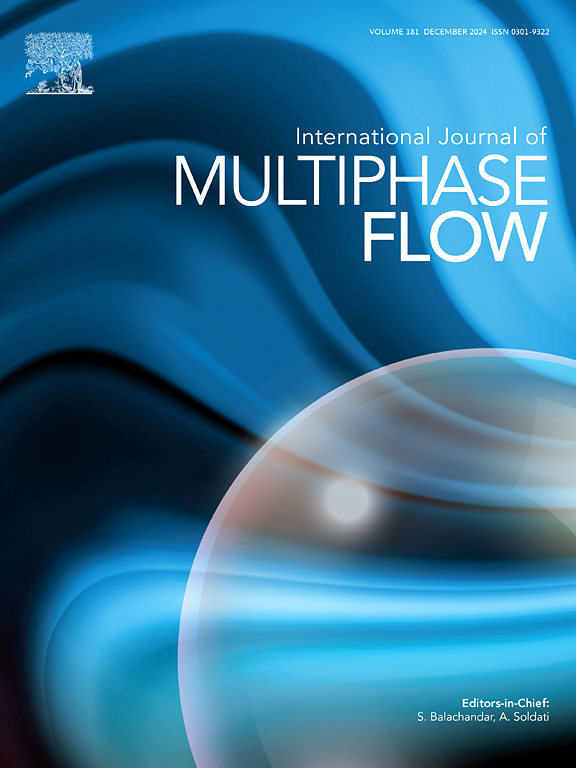多突射流产生气泡云的实验研究
IF 3.8
2区 工程技术
Q1 MECHANICS
International Journal of Multiphase Flow
Pub Date : 2025-04-12
DOI:10.1016/j.ijmultiphaseflow.2025.105238
引用次数: 0
摘要
工业和自然过程经常涉及喷射,这些喷射会破裂成一簇液体柱或液滴,影响液体表面。为了模拟破碎的俯冲射流的空气夹带,我们首先研究由双射流和三射流形成的气泡云。来自单个喷流的气泡云在经过一定的相互作用前深度后合并成为一个统一的云,类似于单个俯冲喷流的情况。然后,我们用六边形填充的多个相同的射流来模拟大型碎片射流。它们产生一个单一的气泡云,而不显示相互作用前的深度。多普勒光学探头测量显示,空气/水的径向分布,φ,最初是双峰的射流撞击后,逐渐过渡到单高斯分布在更深的深度。对于给定的撞击速度Vi,射流数量的增加导致云轴处平均气泡速度的衰减速度变慢。此外,净气流通量不与射流的数量成比例,而是与多射流的直径成比例。在所有情况下,气泡云中的平均气泡大小随着深度的增加而增加,正如高速图像和韦伯数分析所表明的那样,这可能主要是由气泡的合并驱动的。气泡的平均穿透深度H随着射流数量的增加而增加。我们的研究表明,在浮力存在的情况下,动量通量平衡可以成功地用于估计气泡云深度和中心线速度在所有多射流实验中。本文章由计算机程序翻译,如有差异,请以英文原文为准。

Experimental study of bubble clouds generated by multi-plunging jets
Industrial and natural processes frequently involve plunging jets that break into clusters of liquid columns or droplets, impacting the liquid surface. To simulate air entrainment by fragmented plunging jets, we first examine bubble clouds formed by twin and triple identical jets. Bubble clouds from individual jets merge after a certain pre-interaction depth and become a unified cloud, similar to the case of a single plunging jet. We then perform experiments with hexagonally packed multiple identical jets to mimic large fragmented jets. They generate a single bubble cloud without revealing a pre-interaction depth. Doppler optical probe measurements reveal that the radial profiles of air/water fraction, , are initially bimodal just after the jet impact, gradually transitioning into a single Gaussian distribution at further depth. For a given impact velocity , an increase in the number of jets results in a slower decay of the mean bubble speed at the cloud axis. Furthermore, the net air flux does not scale with the number of jets but is proportional to the diameter of the multi-jet. In all cases, the mean bubble size in a bubble cloud increases with depth, which may be primarily driven by the coalescence of bubbles as suggested by high-speed images and Weber number analysis. The mean penetration depth of bubbles, , increases with the number of jets. Our investigations indicate that the momentum flux balance in the presence of buoyancy can be successfully used to estimate bubble cloud depth and the centreline velocity in all multi-jet experiments.
求助全文
通过发布文献求助,成功后即可免费获取论文全文。
去求助
来源期刊
CiteScore
7.30
自引率
10.50%
发文量
244
审稿时长
4 months
期刊介绍:
The International Journal of Multiphase Flow publishes analytical, numerical and experimental articles of lasting interest. The scope of the journal includes all aspects of mass, momentum and energy exchange phenomena among different phases such as occur in disperse flows, gas–liquid and liquid–liquid flows, flows in porous media, boiling, granular flows and others.
The journal publishes full papers, brief communications and conference announcements.

 求助内容:
求助内容: 应助结果提醒方式:
应助结果提醒方式:


